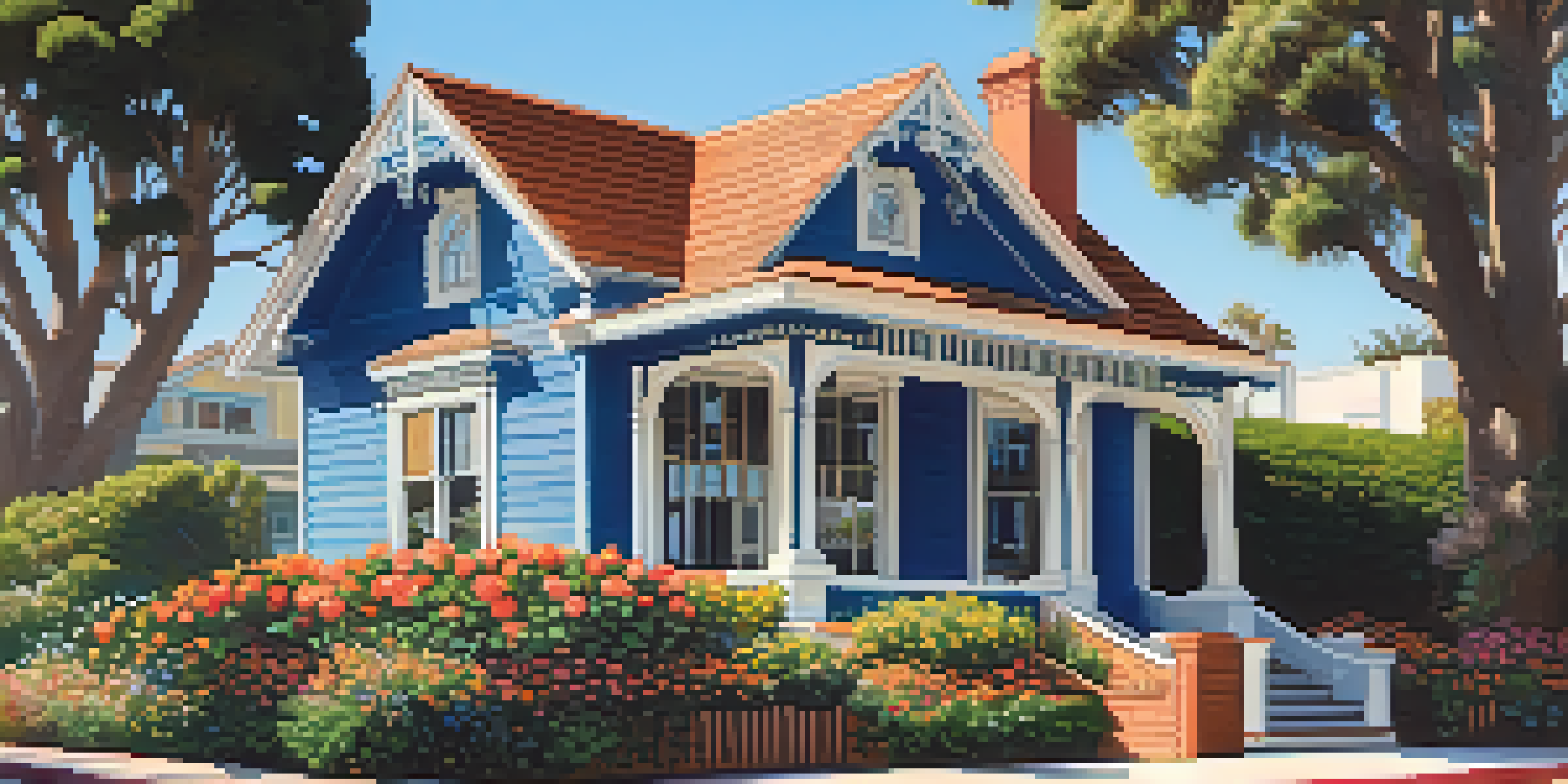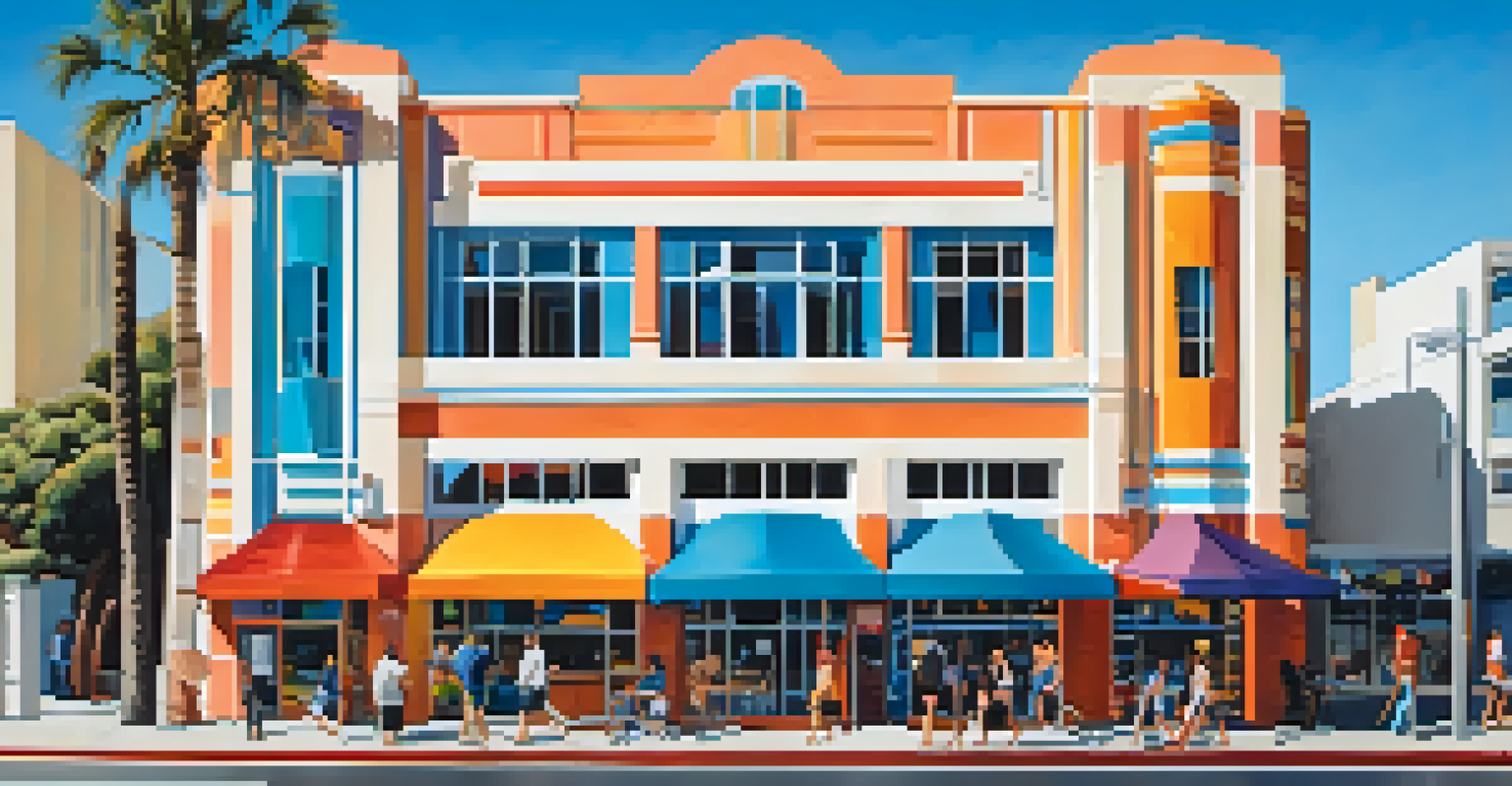The Architecture of Santa Monica: A Journey Through Time

The Origins of Santa Monica's Architectural Style
Santa Monica's architectural journey began in the late 19th century, influenced by its coastal location and burgeoning tourism. The city's early buildings, primarily wooden structures, were designed to accommodate visitors flocking to the beach. This laid the groundwork for a distinctive style that combined functionality with a relaxed, beachy vibe.
Architecture is the learned game, correct and magnificent, of forms assembled in the light.
As the city developed, these structures evolved, incorporating elements from various architectural movements. The Victorian style, with its intricate details and bold colors, became prevalent, reflecting the optimism of the era. This blend of styles not only showcased creativity but also catered to the growing demand for leisure spaces.
Today, remnants of these early designs can still be seen in the charming bungalows and historic hotels that line the streets. They serve as a reminder of Santa Monica's beginnings and the architectural experimentation that followed, setting the stage for what was to come.
The Influence of the Arts and Crafts Movement
In the early 20th century, the Arts and Crafts Movement significantly impacted Santa Monica's architecture. This movement emphasized handmade craftsmanship and simplicity, a response to the industrial age's mass production. Architects in Santa Monica embraced these ideas, incorporating them into their designs for homes and public buildings alike.

One of the most notable examples is the Santa Monica Public Library, which features a blend of brick and wood, embodying the principles of the Arts and Crafts aesthetic. This building not only served as a library but also became a community hub, reflecting the era's emphasis on local culture and craftsmanship.
Santa Monica's Architectural Evolution
The city’s architectural style has evolved through various movements, reflecting its coastal heritage and the influence of changing cultural trends.
As more residents were drawn to Santa Monica, the Arts and Crafts influence continued to shape the city's architectural identity. The result was a collection of structures that felt both personal and inviting, fostering a sense of community in a rapidly growing city.
The Rise of Art Deco and Streamline Moderne
The 1920s and 1930s brought a new wave of architectural style to Santa Monica: Art Deco and Streamline Moderne. These movements celebrated modernity and innovation, often drawing inspiration from the ocean's waves and the sleek lines of machinery. Buildings from this era often featured bold colors, geometric shapes, and ornate details that captured the spirit of the times.
The details are not the details. They make the design.
One standout example is the iconic Santa Monica Looff Hippodrome, which showcases the exuberance of the Art Deco style. Its vibrant colors and playful design elements reflect the lively atmosphere of the beach community during this period. This era not only transformed the skyline but also attracted a new demographic of visitors, eager to experience this fresh architectural vision.
The influence of Art Deco remains visible today, as many of these structures have been preserved and celebrated. They serve as a testament to Santa Monica's ongoing evolution while paying homage to the creativity and innovation that defined the early 20th century.
Mid-Century Modernism: A New Architectural Dawn
The mid-20th century marked a significant shift in Santa Monica's architectural landscape with the emergence of Mid-Century Modernism. This style emphasized simplicity, functionality, and a strong connection to nature, often featuring large windows and open spaces. Architects sought to create homes that blended seamlessly with their surroundings, a concept that resonated deeply in coastal California.
Notable architects like Richard Neutra and Charles Eames left their mark on Santa Monica during this period, designing homes that became iconic symbols of the style. The Eames House, for instance, is a stunning example of how architecture can harmonize with the environment while showcasing innovative design principles. This approach not only elevated residential design but also influenced commercial structures throughout the city.
Emphasis on Sustainability
In the 21st century, Santa Monica has prioritized sustainable architecture, incorporating eco-friendly designs to address environmental concerns.
As a result, Santa Monica became a hub for Mid-Century Modern enthusiasts, drawing attention from architects and designers worldwide. The legacy of this architectural movement continues to inspire new generations, ensuring that the principles of this era remain alive in the city's fabric.
Postmodernism: Embracing Eclecticism and Playfulness
The late 20th century brought about a shift towards Postmodernism in Santa Monica's architecture, characterized by its eclectic and often whimsical style. Architects began to break away from the rigid constraints of Modernism, embracing a mix of historical references and playful designs. This movement allowed for greater creativity and individuality in building designs, leading to a vibrant architectural landscape.
Buildings like the Santa Monica Place shopping center exemplify this shift, featuring bright colors, varied materials, and unexpected shapes. The integration of public art and landscaping into the architectural design also became a hallmark of this era, creating spaces that were not only functional but also visually engaging. This playful approach attracted visitors and residents alike, making the city a destination for architectural exploration.
Postmodernism's influence can still be seen in Santa Monica today, as many new developments embrace these principles. The result is a dynamic urban environment that reflects the city's diverse culture and community, showcasing how architecture can evolve while still honoring its roots.
Sustainable Architecture: A Modern Necessity
As we moved into the 21st century, sustainability became a significant focus in Santa Monica's architectural movement. With increasing awareness of environmental issues, architects and builders began to prioritize eco-friendly designs that minimize energy consumption and reduce waste. This shift reflects a broader trend toward responsible building practices that prioritize the health of the planet.
Many new developments now incorporate green technologies, such as solar panels, rainwater harvesting systems, and energy-efficient materials. The Santa Monica City Hall renovation stands as a prime example, showcasing how modern architecture can embrace sustainability without sacrificing aesthetic appeal. This approach not only benefits the environment but also enhances the quality of life for residents.
Preserving Historical Charm
Efforts to preserve historical architecture in Santa Monica ensure that the city maintains its unique character amidst modernization.
By prioritizing sustainable architecture, Santa Monica demonstrates a commitment to a healthier future. The city's evolving skyline now reflects a harmonious blend of tradition and innovation, setting a standard for other cities to follow as they navigate the challenges of urban development.
Preserving Historical Architecture in a Modern Era
As Santa Monica continues to grow and evolve, the preservation of its historical architecture remains a vital concern. Balancing modernization with the need to protect the city’s architectural heritage is no easy task. City planners and preservationists work tirelessly to ensure that significant structures are maintained while allowing for new developments that respect the past.
The Santa Monica Historic Preservation Program plays a pivotal role in this effort, identifying and protecting buildings that represent the city's rich history. This program not only safeguards architectural landmarks but also fosters community pride and awareness of local history. By celebrating these historical treasures, residents and visitors can appreciate the layers of stories that shaped Santa Monica.

Preservation efforts have allowed the city to maintain its unique character amidst rapid change. The ongoing dialogue between old and new architecture enriches Santa Monica's cultural landscape, ensuring that its historical roots remain an integral part of its vibrant identity.
The Future of Santa Monica's Architectural Landscape
Looking ahead, the future of Santa Monica's architectural landscape is sure to be exciting and transformative. As urbanization continues and new technologies emerge, architects and designers are challenged to create spaces that are both innovative and reflective of the community's values. This ongoing evolution will likely incorporate both sustainability and historical preservation, ensuring a cohesive identity.
Future projects may harness smart building technologies and prioritize community engagement, creating spaces that not only address current needs but also anticipate future demands. By involving residents in the design process, Santa Monica can ensure that its architectural landscape remains a true reflection of its diverse community.
Ultimately, the architecture of Santa Monica will continue to tell a story—a story of adaptation, creativity, and resilience. As the city embraces change while honoring its past, it stands as a beacon of architectural innovation, inviting all to experience its unique journey through time.